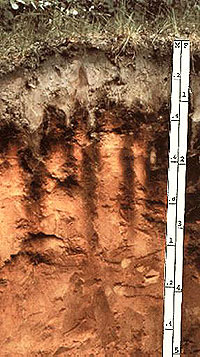|
Land History Geomorphic Regions Soil science |
Soil Science:
The foundation of good land use
In This Section:
Drainage & Water Quality | Where Do Soils Come From? | Soil Orders | More Info
 Soil scientists dig pits to study soil layers. The sequence of layers is called a "profile." Here is a spodosol, a common soil profile in pine flatwoods. (photo courtesy Natural Resources Conservation Service, U.S. Department of Agriculture) |
Scientists have developed a system for classifying soils that is a lot like the one used by biologists for classifying animals and plants. From the most general class to most specific, soils are classified in order, suborder, great group, subgroup, family, and - at the most detailed level - soil series. Dozens of characteristics are considered in soil classification, from the processes that created a particular soil to its response to moisture to its suitability for various uses to its chemical composition and microscopic structure. As with the classification of living things, classification of soils is subject to change and rearrangement as soil scientists dig deeper into their field.
It would be logical to think that for every forest type, there would also be one soil type. Alas, it's not that simple. Some species of plants and animals are very adaptable and can live in a wide variety of soil series. An example of an adaptable species is longleaf pine, one of the premiere tree species in the ARROW region, which can tolerate both wet and dry soils. Other species have very specific requirements for the kinds of soils in which they can live. For instance, gopher tortoises require soils that are dry and sandy for several feet below the ground surface so that they can dig their burrows. Other animals, such as Florida black bears, ramble among many different forest types that grow on an even greater number of soil types. Add the fact that people have changed the original forest just about everywhere, and you can see that there's no way to associate a particular soil series with a particular natural community.
Soil drainage and water qualityDuring times of the year when the water table is high and the soil stays wet most of the time, rainwater tends to run off, that is, go elsewhere, just like it does when you add water to a full glass. Some soils have layers that water can't get through very quickly (called "slowly permeable" layers), and the result is runoff. You also get runoff when rain hits artificial, hard, impermeable surfaces, such as roofs, sidewalks, driveways, and parking lots. Runoff water picks up and carries pollutants from the ground surface, such as motor oil, gasoline, dog droppings, and excess lawn fertilizer and pesticides. The soil doesn't get the chance to help filter out pollutants, so the bad stuff is carried by the runoff water to the nearest ditch, sinkhole, pond, lake, stream, river, or bay, where it fouls up natural food chains.
At the other end of the drainage scale, soils through which water can flow are said to be permeable. Some soils in the ARROW region - particularly in areas of higher elevation - are deep sands, and water runs right through them. Unfortunately, such pure sands don't have much ability to filter out pollutants. Such soils are said to have high leaching rates. Waterborne pollutants can go right through such soils and wind up in the aquifer.
Some things, such as septic tanks and agriculture, work best on soils with just the right rate of drainage. Water moves through these soils at a rate of speed that allows the soil to filter out pollutants or grab nutrients later taken up by plants. These soils are known as well-drained, and they are neither excessively drained nor poorly drained.
Where do soils come from?Soils come from what soil scientists call "parent material." Major parent materials in our region include:
There are lots of different soil series in the Apalachicola River's drainage basin, but most of them belong to one of three orders, starting at the state line and moving south:
For more information…
The best sources of soils information are the county Soil Surveys published by the Natural Resources Conservation Service (formerly called the Soil Conservation Service) of the U.S. Department of Agriculture. Ask your local librarian or Cooperative Extension agent. Soil surveys are available for all ARROW counties except Liberty; a one-page soil map for Liberty County was published in 1973.
Note: The content of the website has not been updated since 2005. The site remains online for it's value as legacy content and is unlikely to be updated.